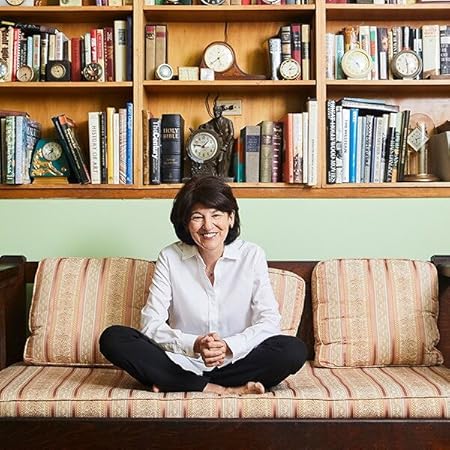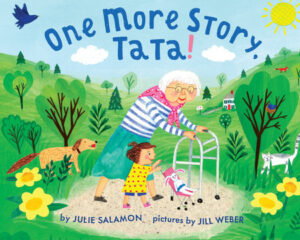Julie Salamon’s picture book ONE MORE STORY, TATA! (Minerva, 2024) thoughtfully explores the loving relationship between young Ruby, her great-grandmother, Tata, and the generations in between. Beautifully illustrated by Jill Weber, ONE MORE STORY, TATA! is a delightful story that emphasizes the importance of sharing our stories and passing down family traditions. I’m so pleased to have the opportunity to interview both Julie and Jill to learn more about their creative work. Welcome!
Julie, despite their age difference, Ruby and her great-grandmother Tata do the same things, like take naps, read, go for a walk, and eat challah on Shabbat. What inspired you to write an intergenerational story?
My sister and I grew up without grandparents, so when we had our children it seemed miraculous that they had this wonderful experience. During the pandemic, our mother Lilly moved to Boston from Florida to live with my sister Suzanne (who happens to be a gerontologist) and her husband Alan. The move coincided with the birth of Suzy’s first grandchild, Ruby, who developed a remarkable relationship with her great-grandmother. All of this happened at a very uncertain time in the world, so watching the connection between these generations was especially meaningful to all of us.
In the book, Tata tells Ruby all about her dreams and life adventures. You indicate in your back matter that Tata is inspired by your mother, Lilly, who “has nine lives, like a cat.” Are there any stories or anecdotes about Lilly that didn’t make it into the book that you’d like to share?
My mother has had an incredible life, that began in Czechoslovakia and wound its way through Auschwitz, New York City, Appalachia (where I grew up), Connecticut and Florida. She endured cruel loss during World War II==her parents, a brother, her home== but never lost her forward momentum. I’ve been writing down her dreams since I was very young. Many of them were quite scary, but even the darkest ones had a positive spin. In dreams and in life my mother always managed to land on her feet. As for stories about her that didn’t make it into the book, there are a million of them! I wrote a nonfiction memoir Called The Net of Dreams about her journey from the Carpathian Mountains to the Appalachian foothills and even that wasn’t enough.
What do you hope young readers and their parents (and grandparents and great-grandparents!) take away from the story?
I hope they take away the power that lies in the stories we learn from our parents and grandparents and great-grandparents. And the joy that can be found in connecting the very old and the very young, and seeing the joys and struggles that make each stage of life a vital experience.

You have written books for adults and children. How is the creative process different (or not so different) for different genres?
The essence of the creative process is always the same. How do you make something out of nothing? But in general, I have found the process of writing for children more fun. I think it connects me to the books I loved so much as a kid, and the freedom I’ve always found in the imagined world.
What were your thoughts when you saw Jill Weber’s illustrations?
This is our fourth book together so I knew the illustrations would be beautiful. But this story is so personal I was worried that her vision might be different from how I saw these characters in my head and heart. Plus, how was she going to convey the dream landscape in a way that made sense to young readers? The instant I saw her first renderings I was overwhelmed with gratitude at her ability to connect with the story so perfectly. The illustrations feel grounded in reality yet are utterly magical.
Thank you, Julie!
Julie Salamon is the New York Times-bestselling author of over ten books, including Wendy and the Lost Boys: the Uncommon Life of Wendy Wasserstein. She is a former film and television critic for the Wall Street Journal and the New York Times.

Jill, what were your thoughts when you first read the manuscript for ONE MORE STORY, TATA!?
Firstly, I was instantly overcome by the warmth and joy. Next I went right to my big wonderful tribe of a family focusing on how special the relationship was with my mother and my granddaughters. My last thoughts were with my pencil, where I began to explore how my pictures were going to convey the many levels of family engagement, as well integrate the imaginative stories in a way that would be relatable to a very small child.
Did you collaborate with Julie, or did you work separately?
This is our fourth book together, so I believe at this point we had a subliminal collaboration, but once the story was written, then it becomes mine to interpret visually. Julie did load me up with family pictures for frame of reference which definitely gave context to my illustrations—though I confess the first Papa in the story looked just like my husband—Poppy in our family, which I did correct. Once my sketches were delivered, then Julie and the team came on board for the discussion.

Photo Credit: Photo by Orianna Riley
What is your creative process like? What is your medium of choice?
I have a big wonderful pad of newsprint where I begin to make sketches and notes thinking out loud with my pencil—while also breaking the text into pages. My next step is to create a storyboard—or the overview of the action and the perspective. It should read like a movie. Then I dive into the individual pages for my sketches. For the final art, my process was different than usual. All the painting was done traditionally with acrylic gouache, colored pencils and spot of crayon. But this time I wanted the freedom to experiment with backgrounds especially for the dream sequences, so those were painted separately from the characters and the details. Everything was scanned into Photoshop and collaged together. Instead of having 17 spreads, I have a drawer full of pieces, but it was so much fun!
In ONE MORE STORY, TATA! you incorporate adorable family pets that will surely endear readers. Can you share a bit about how you create subtext for picture books?
A picture book story comes with the minimal amount of words, so my job is to design everything—the sets, the costumes, and the characters. Since I am imagining the room, I would always have animals (I live with two cats, Jules & Jim and a large German Shepherd named Lottie). The details are the icing on the cake—patterns on the clothing, the books on a shelf, the pictures on the wall, what kind of couch. For me, the more to see, the more engaged I am.
Thank you, Jill!
Jill Weber is a children’s book illustrator whose books include The Story of Hanukkah, a New York Times holiday pick, The Story of Passover, Goodnight Bubbala, and New York Times bestseller The Christmas Tree, which was written by Julie Salamon.
What a woman, I can’t wait to read a book she inspired.
Thanks so much for stopping by, Liz. It’s a delightful book about family. Love it!